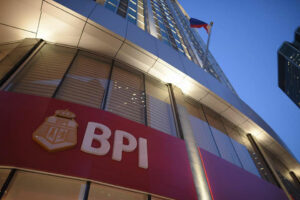BPI posts record net income on robust revenues
BANK of the Philippine Islands (BPI) saw its net profit grow by 29.4% to P17.4 billion in the third quarter as its revenues increased, it said on Thursday, Its third-quarter net income was its highest quarterly profit to date, BPI said in a disclosure to the stock exchange. This brought its nine-month net earnings to […]

BANK of the Philippine Islands (BPI) saw its net profit grow by 29.4% to P17.4 billion in the third quarter as its revenues increased, it said on Thursday,
Its third-quarter net income was its highest quarterly profit to date, BPI said in a disclosure to the stock exchange.
This brought its nine-month net earnings to a record-high P48 billion, 24.3% higher year on year, “driven by robust revenue growth and sustained positive operating leverage,” it said.
This translated to a return on equity of 15.9% and a return on assets of 2.1%.
BPI’s financial statement was unavailable as of press time.
The bank’s revenues grew by 26.3% to P44.6 billion in the third quarter.
For the first nine months, its top line increased by 24.7% year on year to P125.8 billion.
Revenue growth in the period was driven mainly by the 22.2% increase in its net interest income to P93.8 billion, BPI said, as average loans expanded by 18.9% and its net interest margin widened by 22 basis points (bps) to 4.29%.
“Non-interest income rose 32.4% to P31.9 billion from securities trading gains of P3 billion while fee income also increased 28% year on year to P26.4 billion, attributable to higher service charges, credit card fees, and bancassurance income,” it added.
Meanwhile, the bank’s operating expenses grew by 22.1% to P59.4 billion in the nine months ended September due to higher manpower, transaction processing, and technology costs.
This resulted in a cost-to-income ratio of 47.2%.
BPI’s provisions also surged by 60% year on year to P4.8 billion in the period.
The bank’s gross loans expanded by 18.9% to P2.1 trillion at end-September as it saw growth across all segments. Personal loans rose by 103.3%, business banking went up by 99.3%, and microfinance loans grew by 65.2%, it said.
“On a sequential quarter-on-quarter basis, the NPL (nonperforming loan) ratio increased only 10 bps to 2.3%, with sufficient NPL coverage at 111.17%,” BPI added.
On the funding side, total deposits with the bank went up by 14.5% to P2.5 trillion in the period, with the current account, savings account or CASA ratio at 63%.
Its loan-to-deposit ratio was at 85.9%.
BPI’s total assets stood at P3.2 trillion as of September, expanding by 17.2% year on year.
Total equity was at P433.3 billion. The bank’s indicative common equity Tier 1 ratio was at 14.8% and its capital adequacy ratio was at 15.5%, both above regulatory requirements.
“Earnings per share for the first nine months stood at P9.10, up 16.5% from last year’s P7.81, notwithstanding the additional shares issued for the BPI and RBC (Robinsons Bank Corp.) merger,” it said.
The merger between BPI and RBC took effect on Jan. 1, with BPI as the surviving entity. BPI expects to fully integrate RBC’s systems into its own in about two years.
BPI’s shares gained P1.90 or 1.35% to end at P142.50 apiece on Thursday. — Aaron Michael C. Sy























